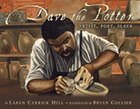
 This glorious collaboration between Laban Carrick Hill (Harlem Stomp!) and Bryan Collier (Martin's Big Words) demonstrates how one man's creativity and imagination transcends any attempt to chain him down. Through the language of metaphor, Hill introduces us to Dave the potter, who lived at the turn of the 19th century, and the South Carolina clay so integral to his art. "To us,/ it is just dirt,/ the ground we walk on," the book begins, as Collier's opening portrait depicts a man sifting "gritty grains" through his sizable hands, gazing at it as reverently as if it were gold dust. "But to Dave/ it was clay,/ the plain and basic stuff/ upon which he learned to/ form a life/ as a slave nearly/ two hundred years ago."
This glorious collaboration between Laban Carrick Hill (Harlem Stomp!) and Bryan Collier (Martin's Big Words) demonstrates how one man's creativity and imagination transcends any attempt to chain him down. Through the language of metaphor, Hill introduces us to Dave the potter, who lived at the turn of the 19th century, and the South Carolina clay so integral to his art. "To us,/ it is just dirt,/ the ground we walk on," the book begins, as Collier's opening portrait depicts a man sifting "gritty grains" through his sizable hands, gazing at it as reverently as if it were gold dust. "But to Dave/ it was clay,/ the plain and basic stuff/ upon which he learned to/ form a life/ as a slave nearly/ two hundred years ago."
This opening contrast hints that there is much to discover beyond what we can see on the surface. "To us/ it is just a pot,/ round and tall/ .../ But to Dave,/ it was a pot/ large enough to store a season's grain harvest,/ to put up salted meat,/ to hold memories." At first glance, our eyes take in the shape of the pot, the texture of its outer surface, the echo of a rounded shape in the sky that resembles a rainbow. But on closer inspection, we see that the pot sits on a shore, surrounded by breaking waves, and a schooner sails on the horizon, ship's hold full of memories of the Middle Passage.
As Dave throws the clay, brought to him in wheelbarrows by others held captive, he demonstrates an enviable level of skill and focus. He works surrounded by Collier's images of Dave's pots--some rendered in watercolors, others with photo collage. The juxtaposition adds texture and contrast. A set of chains and shackles hangs from the studio ceiling in the upper left-hand corner; a phrase pops from the orange collage patchwork that comprises Dave's walls: "friends meeting," a reference to the abolitionist Quakers. The golden dust surrounding the potter's wheel creates a halo around the potter's figure. Collier then segues into a close-up four-panel sequence of Dave molding the pot from a lump of clay ("like a/ magician/ pulling/ a rabbit/ out of/ a hat").
Collier uses snippets of collage that emanate from the pot like feathers to chart the gradual shaping of the jar (its walls "rose up like a robin's/ puffed breast--"). As the jar grows too big for Dave to "wrap his strong arms around it," the collage illustration suggests that Dave embraces the world at large. The branches above him transform into a family tree, each face with eyes closed as if in prayer. Next, as Dave rolls the "long ropes/ of clay between/ his dry, caked palms," captives work the field behind him, in long rows that resemble the ropes of clay. Collier's illustrations show that Dave's craftsmanship transforms his sorrowful history into art that's useful and glorious. Dave invests each vessel with a passion that's evident in the finished pieces (seen in photos in an afterword). His craft grants him freedom.--Jennifer M. Brown

